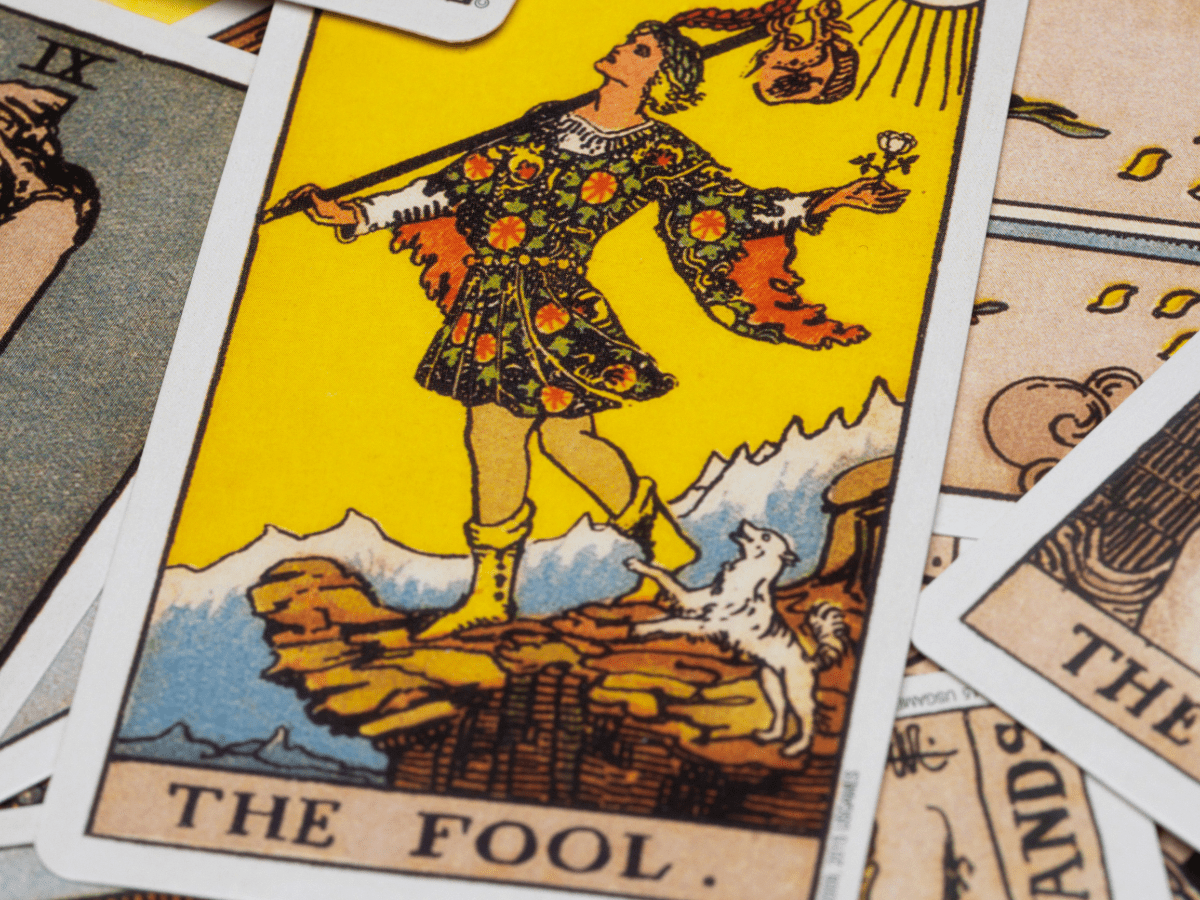This week, I’m doing something different. Tarot lends itself well to video. So, instead of writing about it, I made a video exploring the art and development of the Fool in the tarot. An edited transcript follows.
Transcript
Hello and welcome. Let’s look at the Fool in various tarot decks throughout history.
So, first, we have the Fool in the Tarocchi Visconti Sforza by Il Meneghello. This one is from Milan, 1450. As we can see here, he is going through a rough period. His clothes and shoes are tattered, and he has feathers in his hair. He doesn’t look like he’s having a good time.
This is il Matto from the Sola Busca tarot, although my version of this by Lo Scarabeo, the box says Tarot Alquimistico, the alchemical tarot. So, it’s probably a few years old. I don’t know if that is still in print, but I’m sure you can find it somewhere. And there are other versions of this as well. And here he’s still looking a little bit rough. His shoes or boots or socks are worn away, his clothes are tattered. Here, we see him playing a musical instrument, accompanied by a bird who looks like he’s about to peck his eye out. And he’s still got the feathers. The Sola Busca is roughly from around the 1470s or 1480s.
This is the Fool from the Tarot de Paris, early 1600s. Here, he starts to look more like that court jester. He’s got the two-coloured outfit, bells and tassels hanging from it, and the pointy shoes. And he’s got a baton with something that looks like a court jester.
This is the Fool from the Tarot of Jacques Viéville by Joseph Peterson. A French cardmaker made it in roughly 1650, but it is in the Flemish style. And here he is, still looking like a court jester with a different coloured outfit and the cap, but he doesn’t have those tassels and bells on this one. And he’s got his stick where he’s carrying his belongings.
This is le Fou from the Tarot de Marseille. This is the Noblet by Flornoy. Again, he looks like that court jester looking off in the distance, not concerned that an animal is going at him.
This is the Fool from the Tarocco di Besançon by Il Meneghello. I believe this one is from the 1700s and is a Swiss pattern. Again, he looks like that court jester off in the distance. He’s going somewhere. He looks a bit cheery compared to others, but he seems very unconcerned that some furry creature is biting him.
This is il Matto from the Ancient Italian Tarot by Lo Scarabeo, a Soprafina style. One of the reasons that I like this one is that he is looking right at us. His clothes are tattered. He still has something from a previous life, perhaps as a court jester, but he is definitely on his way somewhere else.
And here we have the Fool from Etteilla. I like this one, too, because although he still looks like a court jester with those clothes, the colours, and his cap with the bells, he’s covering his eyes. It’s like there’s something he doesn’t want to see. Another reason that I like it is that although we sometimes talk about the Fool being at the beginning or the end of the tarot, this one is at the end. He’s number 78.
And here we have the Fool from the tarot deck that changed everything: The Rider-Waite-Smith. This one is the Centennial edition. This is by, of course, A. E. Waite and Pamela Colman Smith, published in 1909. This one just takes on a much more refined appearance and puts the Fool at the mountain, at the edge of the mountain, looking up, holding a flower, and adding a lot more symbolism to it. Waite retained some of the previous meanings associated with this card, such as madness and folly. We still have that with this deck at this point.
Here we have the Thoth deck by Crowley and Lady Frieda Harris, which came out in the late ’60s. Of course, now we have the influence of things like the Golden Dawn and Crowley’s ideas. He changes this a little bit. In this deck, this card is now associated with ideas, thoughts, spirituality, and transcendence in a way that wasn’t before. However, it retains some of its negative associations when it’s ill-dignified.
Then, there is the Fool from the Modern Witch Tarot deck by Lisa Sterle. And although it looks a lot like the Fool from Waite and Pixie, it takes on a completely different meaning in this deck. According to the booklet, this card is associated with passion and optimism, leaving normalcy behind, spontaneity, and all good things, and it encourages you to take the leap. I can read it like that sometimes. The bigger question sometimes is, just because this card comes out and tells you to leap, encourages you to leap, should you take that leap?
Do you have questions, comments, or feedback? Let me know in the comments below. If you enjoyed this video, hit the like button and subscribe. Thanks for watching.

